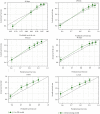Deep-Learning-Based Survival Prediction of Patients in Coronary Care Units
- PMID: 34976110
- PMCID: PMC8720014
- DOI: 10.1155/2021/5745304
Deep-Learning-Based Survival Prediction of Patients in Coronary Care Units
Abstract
Background: A survival prediction model based on deep learning has higher accuracy than the CPH model in predicting the survival of CCU patients, and it also has a better discrimination ability. We collected information on patients with various diseases in coronary care units (CCUs) from the Medical Information Mart for Intensive Care III (MIMIC-III) database. The purpose of this study was to use this information to construct a neural-network model based on deep learning to predict the survival probabilities of patients with conditions that are common in CCUs.
Method: We collected information on patients in the United States with five common diseases in CCUs from 2001 to 2012. We randomly divided the patients into a training cohort and a testing cohort at a ratio of 7 : 3 and applied a survival prediction method based on deep learning to predict their survival probability. We compared our model with the Cox proportional-hazards regression (CPH) model and used the concordance indexes (C-indexes), receiver operating characteristic (ROC) curve, and calibration plots to evaluate the predictive performance of the model.
Results: The 3,388 CCU patients included in the study were randomly divided into 2,371 in the training cohort and 1,017 in the testing cohort. The stepwise regression results showed that the important factors affecting patient survival were the type of disease, age, race, anion gap, glucose, neutrophils, white blood cells, potassium, creatine kinase, and blood urea nitrogen (P < 0.05). We used the training cohort to construct a deep-learning model, for which the C-index was 0.833, or about 5% higher than that for the CPH model (0.786). The C-index of the deep-learning model for the test cohort was 0.822, which was also higher than that for the CPH model (0.782). The areas under the ROC curve for the 28-day, 90-day, and 1-year survival probabilities were 0.875, 0.865, and 0.874, respectively, in the deep-learning model, respectively, and 0.830, 0.843, and 0.806 in the CPH model. These values indicate that the survival analysis model based on deep learning is better than the traditional CPH model in predicting the survival of CCU patients.
Conclusion: A survival prediction model based on deep learning has higher accuracy than the CPH model in predicting the survival of CCU patients, and it also has a better discrimination ability.
Copyright © 2021 Rui Yang et al.
Conflict of interest statement
The authors declare that they have no conflict of interest.
Figures






Similar articles
-
Deep learning models for predicting the survival of patients with hepatocellular carcinoma based on a surveillance, epidemiology, and end results (SEER) database analysis.Sci Rep. 2024 Jun 9;14(1):13232. doi: 10.1038/s41598-024-63531-9. Sci Rep. 2024. PMID: 38853169 Free PMC article.
-
Comparison of deep learning models to traditional Cox regression in predicting survival of colon cancer: Based on the SEER database.J Gastroenterol Hepatol. 2024 Sep;39(9):1816-1826. doi: 10.1111/jgh.16598. Epub 2024 May 9. J Gastroenterol Hepatol. 2024. PMID: 38725241
-
Deep-learning model for predicting the survival of rectal adenocarcinoma patients based on a surveillance, epidemiology, and end results analysis.BMC Cancer. 2022 Feb 25;22(1):210. doi: 10.1186/s12885-022-09217-9. BMC Cancer. 2022. PMID: 35216571 Free PMC article.
-
Deep learning enabled prediction of 5-year survival in pediatric genitourinary rhabdomyosarcoma.Surg Oncol. 2021 Mar;36:23-27. doi: 10.1016/j.suronc.2020.11.002. Epub 2020 Nov 20. Surg Oncol. 2021. PMID: 33276260
-
Deep learning-based survival prediction of oral cancer patients.Sci Rep. 2019 May 6;9(1):6994. doi: 10.1038/s41598-019-43372-7. Sci Rep. 2019. PMID: 31061433 Free PMC article.
Cited by
-
Deep-learning-based survival prediction of patients with lower limb melanoma.Discov Oncol. 2023 Nov 30;14(1):218. doi: 10.1007/s12672-023-00823-y. Discov Oncol. 2023. PMID: 38030951 Free PMC article.
-
A novel staging system based on deep learning for overall survival in patients with esophageal squamous cell carcinoma.J Cancer Res Clin Oncol. 2023 Sep;149(11):8935-8944. doi: 10.1007/s00432-023-04842-8. Epub 2023 May 8. J Cancer Res Clin Oncol. 2023. PMID: 37154930 Free PMC article.
-
Multiview Deep Forest for Overall Survival Prediction in Cancer.Comput Math Methods Med. 2023 Jan 18;2023:7931321. doi: 10.1155/2023/7931321. eCollection 2023. Comput Math Methods Med. 2023. PMID: 36714327 Free PMC article.
-
Serum glucose-potassium ratio predicts inhospital mortality in patients admitted to coronary care unit.Rev Assoc Med Bras (1992). 2024 Oct 7;70(10):e20240508. doi: 10.1590/1806-9282.20240508. eCollection 2024. Rev Assoc Med Bras (1992). 2024. PMID: 39383392 Free PMC article.
-
Deep-learning-based survival prediction of patients with cutaneous malignant melanoma.Front Med (Lausanne). 2023 Mar 27;10:1165865. doi: 10.3389/fmed.2023.1165865. eCollection 2023. Front Med (Lausanne). 2023. PMID: 37051218 Free PMC article.
References
-
- Khush K. K., Rapaport E., Waters D. The history of the coronary care unit. Canadian Journal of Cardiology . 2005;21 - PubMed
-
- Hedayati H. A., Farivar S. The role of coronary care unit in reduction of mortality rate and sudden death in acute myocardial infarction. Pahlavi Medical Journal . 1977;8(2):198–207. - PubMed
MeSH terms
LinkOut - more resources
Full Text Sources
Research Materials
Miscellaneous

